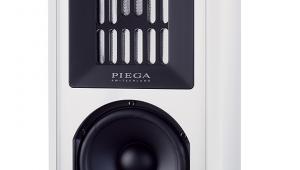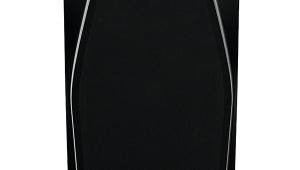Psi A215 M (£5385)
 Although virtually unknown in the UK, PSI can trace its roots back to 1975, when founder Alain Roux first started manufacturing his own loudspeaker designs while still studying at the Lausanne École Polytechnique Fédérale.
Although virtually unknown in the UK, PSI can trace its roots back to 1975, when founder Alain Roux first started manufacturing his own loudspeaker designs while still studying at the Lausanne École Polytechnique Fédérale.
Over the past 35 years, this Swiss company has produced a range of custom, domestic, but mostly professional studio loudspeaker systems. In 1991 an analogue and digital electronics section was added to the acoustic laboratory at its Yverden manufacturing facility. The current mainstay of PSI’s manufacturing output is a range of no fewer than six active studio monitors of various sizes and matching sub. ‘More than a black box’, to quote the sales blurb.
All models incorporate their own sophisticated dedicated electronics and custom drive-unit technologies. PSI claims it has a product with the A215-M floorstander that bridges across the traditional professional and domestic boundaries, and considers it a reference product for its small physical size in either category.
PSI says it has targeted such design objectives as phase response, impulse behaviour and controlled in-room sound dispersion patterns. Two apparently unique systems are incorporated within all its designs.
Compensated Phase Response uses a selection of filters within the active crossover to compensate for the loudspeaker’s in-built phase delays, both electrical and mechanical – thereby aiming to maintain smooth frequency and fast transient responses.
Adaptive Output Impedance is a kind of motional feedback system. The circuitry monitors the movement of the loudspeaker membrane and motor system, and constantly adjusts the damping rate for optimal performance, in a bid to improve impulse behaviour and maintain low coloration.
So effective is this system, claims PSI, that it can actually help damp out in-room colorations and interference from other nearby speaker systems (these would be more problematic in a studio environment, of course). This kind of processing is only available with a loudspeaker system incorporating in-built amplification. All the PSI models feature efficient Glass G amplifier technologies, with fully balanced inputs and user adjustable high-pass filters.
TAKEN AS RED
There is simply no mistaking the speaker’s studio heritage: our review model was finished in a hardwearing semi-gloss paint finish listed as Studio Red (a metallic black is available for a £300 premium), complete with fixed, punched metal grilles on the mid-bass units, but having an exposed bass reflex port and tweeters, plus a front tell-tale power LED. It’s all very glitzy.
However, the cabinet is a very slender at 166mm wide, 250mm in depth and 1110mm in height, with a weight of just under 16kg. The cabinet incorporates four short metal arms, as seen in our photographs, which swing out from the base of the enclosure to provide stability. But these are fitted with felt pads, and there is no standard provision for carpet spikes (although the holes on the bases are a decent enough M6 thread, and would take 6mm metal spikes).
Each cabinet incorporates two 105mm polypropylene mid-bass drivers, with a single 25mm polymer soft dome tweeter quite deeply recessed between the two main units; and there is a reflex slot at the bottom of the cabinet. The Class G amplification is specified at 120W for the pair of mid-bass drivers and 40W for the tweeter. Maximum SPL is claimed to be 117dB at 1m – incredibly loud.
Connections on the rear are switched IEC mains input and a balanced XLR input (there is no provision for phono or even an unbalanced jack socket). Input level and low frequency roll-off adjustment is also provided on the rear panel. At the front of the cabinet the green power LED will change to red on loud peaks, finally turning the speaker off in case of overload. The units should feature an auto standby control, which PSI describes on its web site as ‘Phantom Standby Control’, although this did not seem to operate on the supplied pair. Build quality is to a high standard; the A215-M feels both solid and robust.
SIT WHERE YOU LIKE
With its in-built amplification, setting-up the A215-Ms was something of a doddle. I used a mix of PC based server and Philips CD transport feeding a Marantz Project D1 multi-bit DAC, the latter’s fully balanced signal fed via a simple passive attenuator to the A215-Ms. For my own amusement, a Studer A810 playing 30ips master tapes was also used for one evening’s analogue
entertainment. Cables were from Chord Company’s Sarum range.
Positioning the speakers proved easy and most effective when spaced 3m apart and 1m from the back wall, 65cm in from side walls, and with the speakers toed in towards a listening seat set 4m away.
From the first track onwards, it was pretty clear that this was a weighty performer. The sound had an instant ‘gravity’ – a solidity that defied the size of the enclosures. What was also noticeable was the very accommodating listening position: there wasn’t the traditional hot spot. And the A215-Ms presented a very wide soundstage, which didn’t change whether one stood up or sat down, and one which improved further moving down the length of the listening room.
In ‘Electronica’ mode, tracks from William Orbit’s Hello Waveforms [Sanctury Records] suited this speaker down to the ground. With pure synthesizer and having lots of low bass energy it was quite an impressive experience. Hybrid Device’s self-titled album Hybrid Device [Shadow Recordings SDW088-2], another Electronica fest, was again very well represented, with good detailing and dynamics. This little speaker really could play quite loud, although perhaps not quite to the degree the specifications had hinted at. The classic 1964 Jimmy Smith Hammond organ recording of ‘Basin Street Blues’, from The Cat [Verve 539 756-2], quite upset the on-board protection circuits. The mix of Hammond organ bass and real acoustic bass almost proved too much, prompting a constant flickering of the front LEDs to red; and after three minutes at a not unreasonable level, the left-hand speaker shut off completely.
While on the subject of bass: there is quite a lot of it with this speaker. And frankly, not all of it totally accurate. It is deep, and defined, but the cabinet is clearly offering ‘input’, the choice of a low positioned wide-mouthed port seeming to energise the room with far too much bass; and without a proper grounding (ie, by spikes) the cabinet was free to come along for the ride... regardless of genre.
Where this mattered less was in recordings which were, let’s say, less than audiophile in quality. Playing Music For The Jilted Generation by The Prodigy [XL Recordings] offered a great experience, for on most systems tracks like these will simply sound thin and under-developed. Here the track ‘Poison’ attained real power.
Running through some more vocal material did show up further shortcomings. The Dowland Project’s 2001 Care-charming Sleep [ECM New Series] features the sonorous vocals of John Potter in a simple acoustic set with playing in an early Baroque style. Normally this is a very wide-open recording, and one that tends to sound impressive on most systems. Here it was good, but just a tad held back – frankly a little flat and uninteresting. Given the massive dynamics available, the expansive sound stage, and right ‘feel’ of this speaker, this was a mild disappointment. The whole sound was smooth, very wide, and very flat – and I am not just talking about the frequency response!
On Stravinsky’s The Soldier’s Tale (the Australian Eloquence CD transfer discussed in Christopher Breunig’s January Opinion) the three main actors were rigidly and firmly placed across the speaker’s stereo image, yet not really coming into the room – and managing again to just lack some fizz, some energy... The chamber group was convincing enough, but nonetheless lacking in breadth and detail.
PUZZLING VARIABILITY
Jazz At The Pawn Shop [Proprius] worked much better, and on the 1977 Rumours from Fleetwood Mac [Warner] the speakers earned back some brownie points. ‘The Chain’ was very impressive, but at higher replay levels, when the vocals really kicked in, the sound began to harden up in the midrange, while remaining quite clear in the treble.
The treble itself was set at about the right level: it was not as detailed as with some systems at this price point, and I was at pains to determine whether I was listening to the internal amplifier creating a subdued softening effect, or the drive unit itself. But there was a definite character, manifested as a mild ‘honk’ to the treble.
The speaker did seem to enact a chameleon-like effect at times, and at different sound levels. At low replay levels it was smooth and sophisticated, but with far too much bass, almost as if it had an in-built loudness contour. At medium levels the bass cleared up, but the overall sound then lacked detail and energy, sounding more like ‘hi-fi’ than music. And if pushed to high levels, frankly it fell apart. What was confusing was how it could play some complex stuff very well, but managed to lose the plot on simpler, eg, acoustic, material. Actually, the more ‘studio oriented’ the programme material was, the better this PSI speaker sounded.
VERDICT
The amazing dynamic levels, wide frequency response, easy positioning and stunning dispersion from a compact enclosure are all worthy of praise. This well-built active system is straight out of the studio school and it shows, with very little attention to audiophile detailing – fixed grilles, no spikes, moderate amplification with strong bass port alignment, resulting in a fairly coloured overall sound.
Originally published in the April 2011 issue

























































